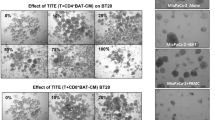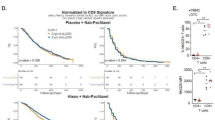Abstract
In this study, we investigated whether activated T cells (ATC) armed with bispecific antibodies (aATC) can inhibits tumor growth and MDSC development in a Th1 cytokine–enriched (IL-2 and IFN-γ) microenvironment. Cytotoxicity mediated by aATC was significantly higher (P < 0.001) against breast cancer cell lines in the presence of Th1 cytokines as compared with control co-cultures. In the presence of aATC, CD33+/CD11b+/CD14−/HLA-DR− MDSC population was reduced significantly under both control (P < 0.03) and Th1-enriched (P < 0.036) culture conditions. Cytokine analysis in the culture supernatants showed high levels of MDSC suppressive chemokines CXCL9 and CXCL10 in Th1-enriched culture supernatants with highly significant increase (P < 0.001) in the presence of aATC. Interestingly, MDSC recovered from co-cultures without aATC showed potent ability to suppress activated T-cell-mediated cytotoxicity (P < 0.001), IFN-γ production (P < 0.01) and T-cell proliferation (P < 0.05) compared to those recovered from aATC-containing co-cultures. These data suggest that aATC can mediate enhanced killing of tumor cells and may suppress MDSC and Treg differentiation, and presence of Th1 cytokines potentiates aATC-induced suppression of MDSC, suggesting that Th1-enriching immunotherapy may be beneficial in cancer treatment.









Similar content being viewed by others
References
Bronte V, Zanovello P (2005) Regulation of immune responses by l-arginine metabolism. Nat Rev Immunol 5(8):641–654
Nagaraj S, Gabrilovich DI (2008) Tumor escape mechanism governed by myeloid-derived suppressor cells. Cancer Res 68(8):2561–2563
Gabrilovich DI, Nagaraj S (2009) Myeloid-derived suppressor cells as regulators of the immune system. Nat Rev Immunol 9(3):162–174
Marigo I, Dolcetti L, Serafini P, Zanovello P, Bronte V (2008) Tumor-induced tolerance and immune suppression by myeloid derived suppressor cells. Immunol Rev 222:162–179
Mantovani A, Schioppa T, Porta C, Allavena P, Sica A (2006) Role of tumor-associated macrophages in tumor progression and invasion. Cancer Metast Rev 25(3):315–322
Mantovani A, Allavena P, Sica A, Balkwill F (2008) Cancer-related inflammation. Nature 454(7203):436–444
Sakaguchi S, Sakaguchi N, Shimizu J et al (2001) Immunologic tolerance maintained by CD25(+) CD4(+) regulatory T cells: their common role in controlling autoimmunity, tumor immunity, and transplantation tolerance. Immunol Rev 182:18–32
Gallina G, Dolcetti L, Serafini P et al (2006) Tumors induce a subset of inflammatory monocytes with immunosuppressive activity on CD8(+) T cells. J Clin Invest 116(10):2777–2790
Serafini P, Borrello I, Bronte V (2006) Myeloid suppressor cells in cancer: recruitment, phenotype, properties, and mechanisms of immune suppression. Semin Cancer Biol 16(1):53–65
Ko JS, Bukowski RM, Fincke JH (2009) Myeloid-derived suppressor cells: a novel therapeutic _target. Curr Oncol Rep 11(2):87–93
Morse MA, Hall JR, Plate JMD (2009) Countering tumor-induced immunosuppression during immunotherapy for pancreatic cancer. Expert Opin Biol Ther 9(3):331–339
Kusmartsev S, Gabrilovich DI (2002) Immature myeloid cells and cancer-associated immune suppression. Cancer Immunol Immunother 51(6):293–298
Kusmartsev S, Gabrilovich DI (2006) Effect of tumor-derived cytokines and growth factors on differentiation and immune suppressive features of myeloid cells in cancer. Cancer Metast Rev 25(3):323–331
Bronte V, Serafini P, Apolloni E, Zanovello P (2001) Tumor-induced immune dysfunctions caused by myeloid suppressor cells. J Immunother 24(6):431–446
Bronte V, Chappell DB, Apolloni E et al (1999) Unopposed production of granulocyte-macrophage colony-stimulating factor by tumors inhibits CD8(+) T cell responses by dysregulating antigen-presenting cell maturation. J Immunol 162(10):5728–5737
Menetrier-Caux C, Montmain G, Dieu MC et al (1998) Inhibition of the differentiation of dendritic cells from CD34(+) progenitors by tumor cells: role of interleukin-6 and macrophage colony-stimulating factor. Blood 92(12):4778–4791
Peranzoni E, Zilio S, Marigo I et al (2010) Myeloid-derived suppressor cell heterogeneity and subset definition. Curr Opin Immunol 22(2):238–244
Nefedova Y, Huang M, Kusmartsev S et al (2004) Hyperactivation of STAT3 is involved in abnormal differentiation of dendritic cells in cancer. J Immunol 172(1):464–474
Davol PA, Gall JM, Grabert RC et al. (2004) Infusions of T cells armed with anti-CD3 × anti-her2/neu bispecific antibody modulate in vivo patient immune responses in phase I clinical trials for breast and hormone refractory prostate cancers. Blood 104(11): 379a. (11-16-2004. Ref Type: Abstract)
Grabert RC, Cousens LP, Smith JA et al (2006) Human T cells armed with Her2/neu bispecific antibodies divide, are cytotoxic, and secrete cytokines with repeated stimulation. Clin Cancer Res 12(2):569–576
Sen M, Wankowski DM, Garlie NK, Siebenlist RE, Van Epps D, LeFever AV et al (2001) Use of anti-CD3 x anti-HER2/neu bispecific antibody for redirecting cytotoxicity of activated T cells toward HER2/neu tumors. J Hematother Stem Cell Res 10:247–260
Lee GY, Kenny PA, Lee EH, Bissell MJ (2007) Three-dimensional culture models of normal and malignant breast epithelial cells. Nat Methods 4(4):359–365
Marigo I, Bosio E, Solito S et al (2010) Tumor-induced tolerance and immune suppression depend on the C/EBP beta transcription factor. Immunity 32(6):790–802
Elkabets M, Ribeiro VSG, Dinarello CA et al (2010) IL-1 beta regulates a novel myeloid-derived suppressor cell subset that impairs NK cell development and function. Eur J Immunol 40(12):3347–3357
Tu S, Bhagat G, Cui G et al (2008) Overexpression of interleukin-1 beta induces gastric inflammation and cancer and mobilizes myeloid-derived suppressor cells in mice. Cancer Cell 14(5):408–419
Loetscher M, Gerber B, Loetscher P et al (1996) Chemokine receptor specific for IP10 and Mig: structure, function, and expression in activated T-lymphocytes. J Exp Med 184(3):963–969
Yoshie O, Imai T, Nomiyama H (2001) Chemokines in immunity. Adv Immunol 78:57–110
Vandercappellen J, Van Damme J, Struyf S (2008) The role of CXC chemokines and their receptors in cancer. Cancer Lett 267(2):226–244
Conti I, Rollins BJ (2004) CCL2 (monocyte chemoattractant protein-1) and cancer. Semin Cancer Biol 14(3):149–154
Loberg RD, Ying C, Craig M, Yan L, Snyder LA, Pienta KJ (2007) CCL2 as an important mediator of prostate cancer growth in vivo through the regulation of macrophage infiltration. Neoplasia 9(7):556–562
Hasegawa H, Inoue A, Muraoka M, Yamanouchi J, Miyazaki T, Yasukawa M (2007) Therapy for pneumonitis and sialadenitis by accumulation of CCR2-expressing CD4(+)CD25(+) regulatory T cells in MRL/lpr mice. Arthr Res Ther 9(1):1–12
Huang B, Lei Z, Zhao J et al (2007) CCL2/CCR2 pathway mediates recruitment of myeloid suppressor cells to cancers. Cancer Lett 252(1):86–92
Dunn GP, Old LJ, Schreiber RD (2004) The immunobiology of cancer immunosurveillance and immunoediting. Immunity 21(2):137–148
Mullins DW, Anderson SG, Mayer ME et al (2004) Chemokine receptor expression patterns on activated CD8(+) T lymphocytes correlate with survival in melanoma patients receiving peptide-based immunotherapy. FASEB J 18(4):A64–A65
Mullins IM, Slingluff CL, Lee JK et al (2004) CXC chemokine receptor 3 expression by activated CD8(+) T cells is associated with survival in melanoma patients with stage III disease. Cancer Res 64(21):7697–7701
Harlin H, Meng Y, Peterson AC et al (2009) Chemokine expression in melanoma metastases associated with CD8(+) T-cell recruitment. Cancer Res 69(7):3077–3085
Liu YQ, Poon RT, Hughes J, Feng XQ, Yu WC, Fan ST (2005) Chemokine receptors support infiltration of lymphocyte subpopulations in human hepatocellular carcinoma. Clin Immunol 114(2):174–182
Shin EC, Shin WC, Choi Y, Kim H, Park JH, Kim SJ (2001) Effect of interferon-gamma on the susceptibility to Fas (CD95/APO-1)-mediated cell death in human hepatoma cells. Cancer Immunol Immunother 50(1):23–30
Selleck WA, Canfield SE, Hassen WA et al (2003) IFN-gamma sensitization of prostate cancer cells to Fas-mediated death: a gene therapy approach. Mol Ther 7(2):185–192
Sinha P, Chornoguz O, Clements VK, Artemenko KA, Zubarev RA, Ostrand-Rosenberg S (2011) Myeloid-derived suppressor cells express the death receptor Fas and apoptose in response to T cell-expressed FasL. Blood 117(20):5381–5390
Nonaka K, Saio M, Suwa T et al (2008) Skewing the Th cell phenotype toward Th1 alters the maturation of tumor-infiltrating mononuclear phagocytes. J Leukoc Biol 84(3):679–688
Acknowledgments
These studies were funded in part by R01 CA 092344 (L.G.L.), R01 CA 140412 (L.G.L), 5P39 CA 022453 from National Cancer Institute, Translational Grants #6066-06 and #6092-09 from the Leukemia and Lymphoma Society (L.G.L), Susan G. Komen Foundation Translational Grant #BCTR0707125 (L.G.L), and Michigan Cell Therapy Center for Excellence Grant from the State of Michigan #1819, and startup funds from the Barbara Ann Karmanos Cancer Institute.
Conflict of interest
L.G.L. hold founder’s shares of Trans_target, Inc. The other authors have no financial conflict of interest.
Author information
Authors and Affiliations
Corresponding author
Rights and permissions
About this article
Cite this article
Thakur, A., Schalk, D., Sarkar, S.H. et al. A Th1 cytokine–enriched microenvironment enhances tumor killing by activated T cells armed with bispecific antibodies and inhibits the development of myeloid-derived suppressor cells. Cancer Immunol Immunother 61, 497–509 (2012). https://doi.org/10.1007/s00262-011-1116-1
Received:
Accepted:
Published:
Issue Date:
DOI: https://doi.org/10.1007/s00262-011-1116-1




